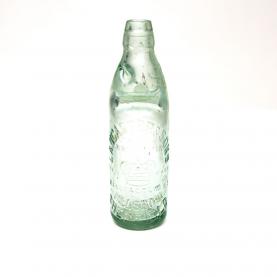Mineral water
The medicinal properties of mineral waters were already known back in Roman times. The Romans enjoyed thermal baths and transported water in amphorae. In 19th century Europe, the discovery of polluted water in distribution systems encouraged the trade in bottled mineral water, synonymous with purity. Since the Second World War, mineral water sales have been boosted through changes in consumption patterns.
A brief history of thermal baths and the bottled mineral water trade
The history of mineral waters is closely linked to its past use in thermal baths, when its health benefits became evident. The Ancient Romans created extensive water distribution systems in their Empire and collected water from the ground using a water wheel, before discovering the piston pump. Like the Celts, the Romans were aware of the therapeutic properties of mineral water springs and frequented thermal baths. They were the first to carry water in amphorae, the precursors of the bottles we use today. Following the invasions and epidemics of the Middle Ages, spa resorts and mineral waters lost their appeal in Europe. They became fashionable once again in the 14th century through the Arabic influence in Spain. In the 19th century, the major European cities introduced sanitation and running water became more widespread. Concurrently, the discovery of polluted water, believed to cause typhoid and cholera, led to the development of trade in bottled mineral water at the end of the century. Bottled mineral water was synonymous with purity. After the Second World War, mineral water sales were boosted by advertising and benefited from growth in income. Nestlé became the world’s leading bottled water producer in 2008. In 2015, the firm owned 52 different water brands such as Contrex, Vittel and Perrier.
An example of mineral water bottling
Nestlé Waters France owns ten different mineral water brands and produces several billion bottles each year. The process begins with the recycling of PET (polyester) bottles. To give the bottles their shape, PET resin preforms are softened by heat and then stretched and blown. The bottles are then rinsed by air injection and filled with water by bottle fillers. To prevent contamination, the bottles are immediately capped, then labelled and marked by laser. This marking is used for indicating the best before date and the batch number to ensure traceability. The bottles are then grouped together in batches of six or eight and wrapped with packaging film to create water packs for easier transportation. The packs are stacked onto pallets and covered with a waterproof, UV-proof cover for optimal protection during transportation and storage.
From thermal baths to bottled water: the example of Perrier
The Perrier mineral water spring, known for its baths since Antiquity, is located in Vergèze in Gars, a volcanic region of France. Perrier is a carbonated mineral water with a slightly tangy flavour and low mineral and salt content. Its bubbles make it a refreshing drink and give it a festive connotation. The owner of the baths, Dr Louis Perrier discovered the therapeutical properties of the spring water and first marketed it in bottles in the late 19th century. Launched in the United States in 1977, the brand’s iconic green bottle was a great success until the 1990s, when a laboratory discovered benzene (a carcinogenic hydrocarbon used as an industrial solvent) in its bottles. After this crisis was resolved, Nestlé bought the brand in 1992 and launched the plastic 50 cl format in 2001.
CENTRE NATIONAL DE RECHERCHE SCIENTIFIQUE (CNRS). S. d. Dossier scientifique : l’eau. Les eaux de source et les eaux minérales. CNRS [en ligne] [Consulté le 8 décembre 2015]. Disponible à l’adresse : http://www.cnrs.fr
D'ERM, Pascale, 2003. Les eaux minérales. Arles : Éditions du Rouergue.
DUKAN, Pierre, 1998. Eau de Perrier. Dictionnaire de diététique et de nutrition. Paris : Le Cherche Midi. pp. 302-303.
MERCIER, Jacques, 2000. Le grand livre de l’eau. Tournai : La Renaissance du Livre.
MILLWARD, Robert, 2007. La distribution de l'eau dans les villes en Grande Bretagne au 19 e et 20 e siècles : le gouvernement municipal et le dilemme des compagnies privées. Histoire, économie & société. 2/2007. pp. 111-128 [en ligne]. [Consulté le 8 décembre 2015]. Disponible à l’adresse : http://www.cairn.info
NESTLE WATERS. L'embouteillage de l'eau. Nestle Waters [en ligne]. [Consulté le 8 décembre 2015]. Disponible à l’adresse : http://www.nestle-waters.fr
NESTLE WATERS. Our story. Nestle Waters [en ligne]. [Consulté le 8 décembre 2015]. Disponible à l’adresse : http://www.nestle-waters.com
NESTLE WATERS. Perrier. Nestle Waters [en ligne]. [Consulté le 8 décembre 2015]. Disponible à l’adresse : http://www.nestle-waters.com






